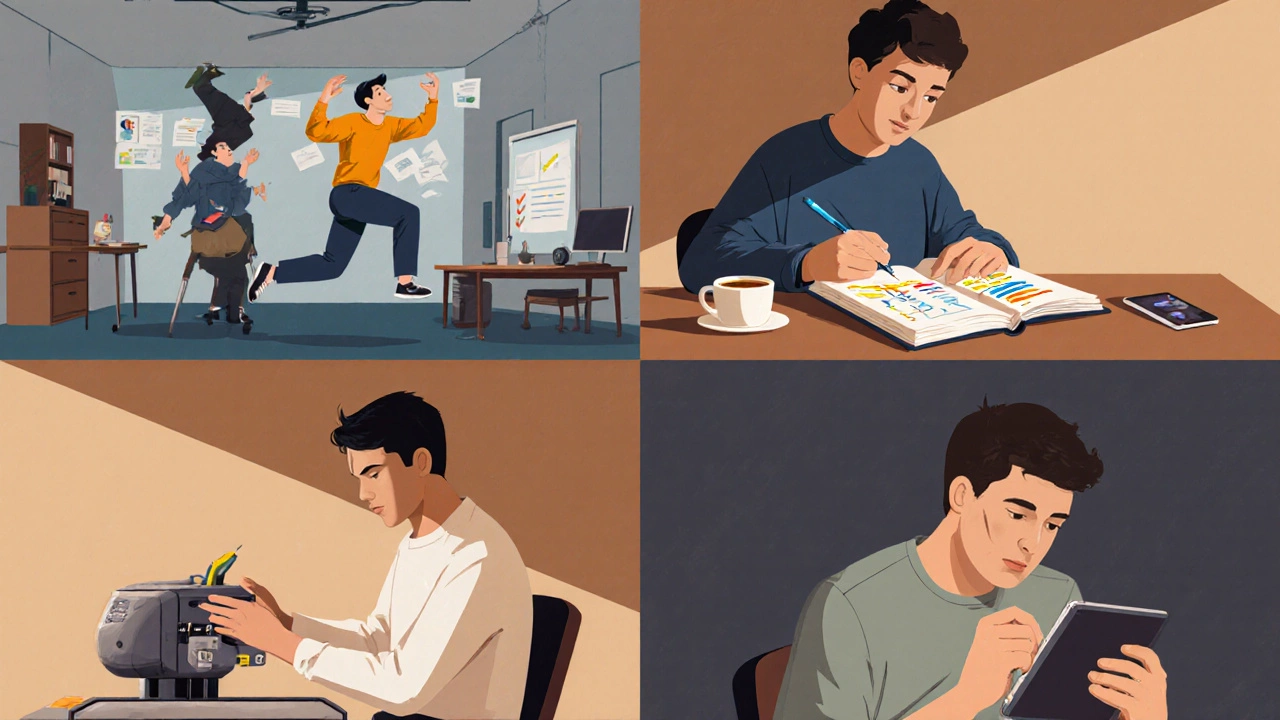Honey and Mumford Learning Style Quiz
How do you learn best?
Answer these 4 questions to discover your dominant learning style. This quiz is based on the Honey and Mumford theory of adult learning styles.
Ever sat through a training session and felt like you were learning in a language no one else understood? Or watched someone else absorb information effortlessly while you struggled to keep up? You’re not broken-you just learn differently. That’s the core idea behind the Honey and Mumford theory, a practical model for understanding how adults learn best.
Where the Honey and Mumford theory came from
The Honey and Mumford theory didn’t appear out of nowhere. It was built on the work of David Kolb, who in the 1980s described learning as a cycle: experiencing something, reflecting on it, forming ideas, and testing those ideas. Peter Honey and Alan Mumford took Kolb’s model and turned it into something usable for real people in real workplaces.
In 1986, they published Learning Style Inventory, a tool that helped adults identify their preferred way of learning. Unlike theories that label people as ‘visual’ or ‘auditory’ learners, Honey and Mumford focused on behavior-how people act when they’re learning. Their model isn’t about what you see or hear. It’s about what you do.
The four learning styles
Honey and Mumford identified four distinct learning styles, each with its own strengths and blind spots. Most adults use a mix, but one usually stands out as their default approach.
- Activists jump in first and think later. They love hands-on tasks, group activities, and challenges. They’re the ones who say, ‘Let’s just try it and see what happens.’ They thrive in workshops, simulations, and role-plays. But they often skip reflection and jump to the next thing before really understanding what worked.
- Reflectors prefer to watch and think before acting. They take notes, observe others, and wait to form opinions. They’re the quiet ones in meetings who ask the smartest questions after everyone’s finished talking. They learn best from case studies, feedback, and time to process. The problem? They can overthink. Sometimes they never get around to doing anything.
- Theorists need to understand the logic behind everything. They want models, frameworks, and clear principles. They’re the ones who ask, ‘What’s the theory behind this?’ and check if it aligns with existing knowledge. They prefer lectures, reading, and structured data. But they can get stuck in analysis paralysis-too busy making sense of things to actually apply them.
- Pragmatists care about what works in the real world. They want practical tips, tools, and techniques they can use tomorrow. They’re impatient with theory unless it leads to action. They learn from demos, problem-solving tasks, and real-life examples. Their weakness? They ignore the bigger picture. If it doesn’t have an immediate use, they tune out.
Why it matters for adult learners
Adults don’t learn like children. They bring experience, responsibilities, and clear goals to learning. They don’t have time for fluff. If a training program doesn’t connect with how they naturally learn, they disengage-or worse, walk away thinking they’re ‘bad at learning’.
Think about a nurse returning to study for a certification. If she’s a reflector, a fast-paced bootcamp will overwhelm her. But if she’s given time to review patient cases and discuss outcomes with peers, she’ll thrive. A pragmatist in the same group might skip the theory entirely and ask, ‘How do I apply this to my shift tomorrow?’
Organizations that ignore this mismatch waste money. A 2022 study by the Australian Institute of Training and Development found that employees who were matched with learning methods aligned to their style completed training 37% faster and retained knowledge 52% longer than those who weren’t.

How to find your learning style
You don’t need a formal test to figure out your style. Just ask yourself these questions after your last learning experience:
- When you learned something new, did you jump right in, or did you wait and watch first?
- Did you prefer a step-by-step guide, or did you learn better by doing it yourself?
- Did you need to understand the ‘why’ before you tried it, or did you just want to know ‘how’?
- After learning, did you feel satisfied by talking it through, writing it down, or putting it into practice?
Most people answer with a mix, but one pattern will stand out. That’s your dominant style.
There’s also a free, 20-question version of the Honey and Mumford Learning Style Questionnaire online. It takes under 10 minutes and gives you a breakdown of your preferences. You don’t need to be an expert to use it.
How trainers and managers can use this
Learning isn’t one-size-fits-all. The best training programs don’t force everyone into the same box. They offer choices.
For example, a leadership course might include:
- A short lecture for theorists (the ‘why’ behind emotional intelligence)
- A video case study for reflectors (watching how a manager handled a conflict)
- A role-play exercise for activists (practicing feedback in pairs)
- A toolkit of scripts and templates for pragmatists (what to say in a tough conversation)
This isn’t harder to design-it’s smarter. You’re not teaching to the average. You’re teaching to the range.
Managers can also use this to support team members. If someone keeps missing deadlines after training, it’s not laziness. Maybe they’re a reflector who needed time to process, or a pragmatist who didn’t see the point. A quick chat-‘What part of that training clicked for you?’-can reveal the gap.

What the theory doesn’t tell you
The Honey and Mumford model is useful, but it’s not a life sentence. People aren’t locked into one style. Your dominant style can shift depending on context. A pragmatist might become a reflector when learning something risky, like financial planning. An activist might slow down when training for surgery.
Also, this model doesn’t say one style is better than another. Activists aren’t ‘impulsive’-they’re adaptable. Theorists aren’t ‘rigid’-they’re precise. The goal isn’t to become all four styles. It’s to understand your default so you can compensate for your blind spots.
For example, if you’re a reflector who needs to lead a team meeting, you can prepare by writing down key points ahead of time. If you’re a theorist stuck in planning mode, you can set a timer to force yourself into action after 30 minutes of research.
Real-world impact: Beyond the classroom
This isn’t just for corporate training. It’s for anyone learning something new as an adult.
Imagine someone going back to study IT after 20 years in retail. If they’re a pragmatist, they’ll quit if they’re forced to memorize syntax without building something real. But if they start by creating a simple website that tracks their grocery budget, they’re hooked.
Or consider a parent learning to use online banking. A reflector might watch three YouTube tutorials before trying. A theorist will read the bank’s help guide cover to cover. An activist will click every button to see what happens. A pragmatist just wants to know: ‘How do I pay my electricity bill without calling customer service?’
Understanding these differences reduces frustration-for the learner and the person helping them.
What to do next
Stop blaming yourself if learning feels hard. You’re not slow. You’re just not being taught in your language.
Start small:
- Identify your dominant learning style using the four questions above.
- Next time you learn something new, choose a method that matches your style-but try one that doesn’t. Stretch yourself.
- If you’re designing or choosing a course, look for programs that offer multiple ways to learn-not just one lecture or one video.
The Honey and Mumford theory doesn’t promise easy learning. But it does promise better learning. When you align how you learn with how you’re taught, you stop fighting yourself-and start moving forward.
Is the Honey and Mumford theory still relevant today?
Yes. While some critics argue that learning styles aren’t scientifically proven to improve outcomes, the real value of Honey and Mumford isn’t in labeling people-it’s in creating flexibility. Modern learning platforms like LinkedIn Learning and Coursera use this model to offer multiple formats: videos, articles, quizzes, and projects. That’s not coincidence. It’s based on the insight that adults learn in different ways. The theory survives because it works in practice, even if the science is debated.
Can someone have more than one learning style?
Absolutely. Most people have a primary style and one or two secondary ones. For example, you might be mostly a reflector but also lean toward pragmatism. That means you like to observe first, but you need to see how it applies before you fully engage. The model isn’t a box-it’s a compass. It helps you understand your preferences, not limit them.
How is Honey and Mumford different from Kolb’s learning cycle?
Kolb described learning as a cycle: concrete experience, reflective observation, abstract conceptualization, and active experimentation. Honey and Mumford took those four stages and turned them into four personality-based learning styles. They didn’t change the cycle-they gave it names and behaviors that real people recognize. Kolb’s model is academic. Honey and Mumford’s is practical.
Do employers still use the Honey and Mumford model?
Many do, especially in the UK, Australia, and parts of Europe. Large organizations like the NHS, BT, and Telstra have used it for decades to design leadership programs and onboarding. It’s not always called out by name, but the structure-offering reflection, practice, theory, and action-is everywhere. It’s become part of the DNA of adult learning design.
Can I change my learning style?
You can’t change your natural preference, but you can strengthen your weaker styles. A theorist can learn to jump in and try things, even if it feels uncomfortable. An activist can learn to pause and reflect before acting. It takes effort, but it’s worth it. The best learners aren’t the ones who stick to what’s easy-they’re the ones who stretch beyond it.

